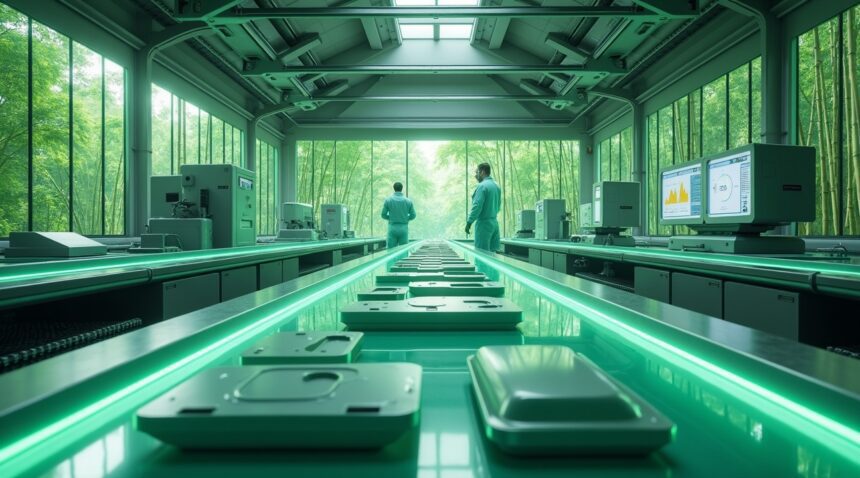Chinese researchers at Northeast Forestry University have developed an innovative bamboo-based material—bamboo molecular plastic (BM-plastic)—that combines the strength of petroleum-based plastics with the environmental advantage of full biodegradability in soil within just 50 days.
Key Takeaways
- BM-plastic offers exceptional mechanical strength with tensile strength up to 110 megapascals, all while being fully biodegradable in just 50 days—bridging the gap between functionality and sustainability.
- The entire production process is eco-friendly, operating at room temperature with non-toxic solvents, ensuring no harmful byproducts and reducing energy usage compared to traditional plastic manufacturing.
- Economic feasibility is a core strength with production costs estimated at $2,300 per ton—positioning BM-plastic between conventional petroleum plastics and higher-cost bioplastics for potential mass-market use.
- The Chinese government supports large-scale application through the Three-Year Action Plan initiated in 2023, which aims to designate bamboo as the leading plastic substitute by 2025. China’s dominance in bamboo production plays a strategic role in this initiative.
- BM-plastic integrates with current industrial systems, demonstrating high compatibility with existing manufacturing equipment across sectors such as automotive, packaging, and construction—ensuring a smooth, cost-effective transition.
A Sustainable Shift in Global Manufacturing
This cutting-edge development stands to revolutionize industries with a sustainable and high-performance material. By combining bamboo’s abundant natural availability with advanced polymer science, BM-plastic presents a promising solution to the global plastic pollution crisis.
To explore the research and details behind the project, you can read more through the official source at this ScienceDirect publication.
Revolutionary Bamboo Material Matches Petroleum Plastic Strength While Biodegrading in 50 Days
I’ve discovered groundbreaking research from Northeast Forestry University in Harbin, China that’s changing how we think about sustainable materials. Their development of bamboo molecular plastic (BM-plastic) represents a significant leap forward in eco-friendly alternatives to petroleum-based plastics.
The material achieves remarkable strength characteristics that surpass most commercial plastics currently available. With tensile strength reaching up to 110 megapascals, BM-plastic demonstrates superior mechanical properties while maintaining complete biodegradability. This combination of strength and environmental responsibility addresses a critical gap in sustainable material science that researchers have been trying to fill for decades.
Exceptional Performance Characteristics
BM-plastic exhibits several impressive performance metrics that position it as a viable replacement for traditional plastics. The material shows a work of fracture that exceeds conventional plastic materials, meaning it can absorb more energy before breaking. Temperature stability remains consistent up to 180°C, making it suitable for various industrial applications that require heat resistance.
Durability testing reveals the material maintains its integrity across extreme temperature ranges. After seven days of exposure to temperatures of 100°C or -30°C, the bamboo plastic shows no signs of degradation. This thermal stability opens up applications in:
- Automotive
- Electronics
- Food packaging industries
The material demonstrates five times greater hardness compared to untreated bamboo, showcasing how molecular engineering has transformed the base material’s properties. Under high humidity conditions of 70%, BM-plastic maintains minimal volume change for a full month, indicating excellent dimensional stability. Additionally, it shows remarkable resistance to strong acids and bases, expanding its potential use in chemical processing environments.
Sustainability and Economic Viability
What sets this bamboo plastic apart is its ability to biodegrade completely in soil within 50 days while maintaining recyclability in a closed-loop system. After recycling, the material retains approximately 90% of its original strength, making it practical for multiple use cycles before final biodegradation.
The production cost estimates place BM-plastic at around $2,300 per ton, positioning it strategically between traditional petroleum plastics and existing bioplastics. This pricing structure suggests commercial viability while companies transition from conventional materials. The cost-effectiveness becomes more attractive when considering the environmental benefits and potential regulatory advantages of using biodegradable materials.
The innovation reminds me of other breakthrough technologies that have transformed industries, similar to how inventive creators are pushing boundaries in their respective fields. Just as technological advancement continues across various sectors, this bamboo plastic development represents a significant step forward in materials science.
Manufacturing processes for BM-plastic could potentially scale up to meet industrial demands while maintaining the material’s exceptional properties. The research team’s success in creating a material that matches petroleum plastic strength while offering complete biodegradability addresses one of the most pressing environmental challenges of our time.
Early applications could include:
- Packaging materials
- Disposable items
- Components that currently rely on traditional plastics
The material’s chemical resistance and thermal stability make it suitable for:
- Automotive parts
- Electronics housings
- Industrial components where durability matters
This breakthrough positions China at the forefront of sustainable materials innovation, potentially influencing global manufacturing practices. As environmental regulations tighten worldwide, materials like BM-plastic offer manufacturers a pathway to compliance without sacrificing performance or significantly increasing costs.
https://www.youtube.com/watch?v=uY1pP-mD2j4
Room-Temperature Manufacturing Process Eliminates Toxic Byproducts
The breakthrough in BM-plastic production centers on a sophisticated two-step solvent-mediated molecular engineering strategy that operates entirely at room temperature. This innovative approach uses a deep eutectic solvent composed of zinc chloride and formic acid, completely eliminating the need for high-heat processing that characterizes traditional plastic manufacturing.
Initial Processing and Solvent Treatment
I find the first step particularly impressive because it involves dissolving bamboo cellulose using a non-toxic alcohol solvent. This gentle dissolution process maintains the integrity of the cellulose structure while preparing it for transformation. The second step introduces ethanol treatment, which triggers dense molecular packing within the cellulose matrix.
The process works by strategically breaking natural hydrogen bonds in the cellulose to enable material flexibility. These bonds are then reformed into a tight and dense structure, creating the final plastic material. This controlled bond manipulation allows manufacturers to achieve the desired strength and flexibility characteristics without compromising the material’s biodegradable properties.
Clean Production with Zero Toxic Waste
What sets this manufacturing process apart from conventional plastic production is its complete absence of toxic byproducts. Traditional petroleum-based plastic manufacturing generates harmful chemicals and requires extensive waste management systems. The bamboo plastic process produces only benign waste materials that pose no environmental threat.
The transformation from gel to solid plastic represents a remarkable physical change. Initially, the material exists in a porous and uneven state, but it gradually transforms into a solid and smooth form through the controlled molecular engineering process. This transformation occurs without external heat application, reducing energy consumption significantly compared to traditional plastic manufacturing.
The moldable nature of the resulting material makes it adaptable for multiple applications across various industries. Manufacturers can shape the BM-plastic into different forms while maintaining its structural integrity and biodegradable characteristics. This flexibility opens doors for applications ranging from packaging materials to consumer products, much like how innovative creators push boundaries in their respective fields.
The room-temperature processing requirement makes this technology accessible to manufacturers worldwide, regardless of their current infrastructure capabilities. Companies won’t need to invest in expensive high-temperature equipment or energy-intensive heating systems to produce this revolutionary material.
China’s Bamboo Dominance Powers Industrial Revolution
China stands as the world’s undisputed bamboo superpower, controlling roughly one-quarter of the global bamboo forest area and producing about one-third of the world’s bamboo output. This massive natural advantage positions the country at the forefront of sustainable material innovation, particularly in the development of biodegradable plastic alternatives. I’ve observed how China’s strategic approach to environmental conservation extends beyond traditional efforts to include revolutionary material science.
Bamboo’s Remarkable Growth Characteristics
The numbers behind bamboo’s potential tell an extraordinary story. Each hectare of bamboo forest yields approximately 78 tons annually—four times more than regular timber production. This productivity stems from bamboo’s incredible growth rate, with some species capable of growing more than one meter per day. The plant reaches full maturity in just 40 days, creating an almost continuous harvest cycle that traditional forestry can’t match.
What makes bamboo particularly revolutionary for industrial applications is its regenerative properties. The entire forest regenerates within five years, while new shoots emerge annually from the same root system without requiring replanting. This self-sustaining cycle creates a virtually inexhaustible raw material source that could transform manufacturing across multiple industries. I’ve seen how this rapid regeneration addresses one of the biggest challenges in sustainable manufacturing: maintaining consistent supply chains without depleting natural resources.
Government-Led Industrial Transformation
China’s commitment to bamboo-based innovation reached a pivotal moment on October 12, 2023, when the National Development and Reform Commission launched its Three-Year Action Plan for Replacing Plastics with Bamboo. This comprehensive strategy aims to establish a complete industrial system by 2025 where bamboo becomes the primary alternative to conventional petroleum-based plastics.
The plan’s scope is ambitious yet practical. Between five and ten demonstration areas are planned by 2025, serving as testing grounds for large-scale bamboo plastic production and application. These demonstration zones will likely become models for global implementation, showcasing how entire regions can transition from petroleum-dependent manufacturing to sustainable bamboo-based alternatives.
This initiative directly supports China’s broader environmental goals, particularly the commitment to achieve national carbon neutrality by 2060. I find it significant that the government has linked bamboo plastic development to climate targets, suggesting this technology represents more than just an environmental experiment—it’s a cornerstone of China’s long-term economic strategy.
The timing of this plan coincides perfectly with growing global pressure to reduce plastic waste and find sustainable alternatives. Major corporations worldwide are actively seeking biodegradable packaging solutions, creating immediate market demand for bamboo plastic products. China’s early investment in this technology could position the country as the primary supplier for a rapidly expanding global market.
Manufacturing facilities are already adapting their processes to accommodate bamboo plastic production. The technology’s compatibility with existing plastic manufacturing equipment means companies can transition without completely overhauling their operations. This practical advantage accelerates adoption rates and reduces the economic barriers that often slow sustainable technology implementation.
China’s bamboo dominance extends beyond raw material availability to include processing expertise and technological innovation. The country has developed sophisticated methods for converting bamboo fibers into plastic-like materials that maintain the strength and versatility of petroleum-based plastics while offering complete biodegradability. This combination of abundant resources, government support, and technological capability creates a unique competitive advantage that other nations will struggle to match.
The rapid pace of innovation in bamboo processing techniques suggests we’re witnessing the early stages of a fundamental shift in global manufacturing. As demonstration areas prove the viability of large-scale bamboo plastic production, other countries will likely seek partnerships or technology transfers to develop their own capabilities.
Environmental Impact Addresses Global Plastic Crisis
I find China’s breakthrough in bamboo plastic represents a crucial turning point in addressing one of our planet’s most pressing environmental challenges. The numbers paint a stark picture of our current predicament: out of the 9.2 billion tons of plastic produced worldwide, about 7 billion tons have ended up as waste, with less than 10% actually getting recycled.
Carbon Sequestration Benefits Beyond Production
Bamboo brings remarkable environmental advantages that extend far beyond its transformation into plastic alternatives. The plant absorbs an estimated 197 million tons of carbon annually and stores approximately 105 million tons. What makes this even more compelling is that bamboo-based products continue to sequester carbon for decades after production, creating a sustained environmental benefit that petroleum-based plastics simply cannot match.
BM-plastic’s biodegradability offers a stark contrast to conventional plastic’s environmental persistence. While traditional plastics can take hundreds of years to decompose, this innovative material breaks down completely in soil within less than two months without polluting the environment. This rapid decomposition timeline addresses one of the most significant problems with current plastic waste management systems.
The scale of the global plastic crisis demands immediate action. According to the UN, over 400 million tons of plastic are produced annually worldwide, with nearly half used for single-use items. These statistics become even more alarming when considering that microplastics have already infiltrated marine ecosystems, food chains, and even human bloodstreams. The widespread contamination demonstrates how urgently we need alternatives like innovative technologies that can replace harmful materials.
China’s bamboo plastic innovation directly tackles these environmental concerns by offering a material that matches petroleum plastic’s strength while eliminating its long-term environmental damage. The timing couldn’t be better, as global discussions are currently underway to establish a legally binding treaty by 2025 aimed at reducing plastic waste. This bamboo-based solution provides a viable pathway for countries and industries to meet increasingly stringent environmental regulations.
The environmental advantages extend beyond just waste reduction. Traditional plastic production relies heavily on fossil fuel extraction and processing, contributing significantly to greenhouse gas emissions. Bamboo cultivation, conversely, actively removes carbon dioxide from the atmosphere while requiring minimal water and no pesticides for growth. This creates a positive environmental cycle rather than the destructive one associated with petroleum-based materials.
Marine ecosystems stand to benefit tremendously from widespread adoption of bamboo plastic. Current plastic pollution has created massive garbage patches in our oceans, with marine life frequently ingesting plastic debris or becoming entangled in discarded materials. The rapid biodegradation of bamboo plastic means that any items accidentally entering marine environments would break down quickly without causing long-term harm to wildlife.
The technology also addresses the fundamental problem of plastic waste accumulation in landfills and natural environments. Traditional plastics persist for centuries, creating growing mountains of waste that leach harmful chemicals into soil and groundwater. Bamboo plastic’s 50-day decomposition timeline transforms waste management from a long-term storage problem into a manageable organic process.
Manufacturing industries face increasing pressure to adopt sustainable practices, and bamboo plastic offers a solution that doesn’t require compromising product quality or performance. The material’s strength characteristics match those of petroleum plastics, allowing manufacturers to maintain existing production processes while dramatically reducing their environmental footprint. This compatibility factor could accelerate adoption across multiple industries, from packaging to consumer goods.
The global shift away from petroleum-based plastics has already begun, with many countries implementing bans on single-use plastic items. China’s bamboo plastic innovation provides a practical alternative that supports these policy initiatives while meeting consumer and industry needs. As international pressure mounts to address plastic pollution, solutions like this become essential tools for environmental preservation and sustainable development.

Industrial Applications Transform Automotive and Manufacturing Sectors
Contemporary vehicles contain nearly 50% plastic by volume, creating an enormous opportunity for sustainable alternatives like bamboo-derived BM-plastic. This breakthrough material offers manufacturers a direct replacement path without requiring costly equipment overhauls or production line modifications.
Automotive Revolution Through Sustainable Materials
Car manufacturers can integrate BM-plastic across multiple vehicle systems, from interior components to structural elements. The material shows exceptional promise for dashboards, bumpers, cable insulation, and various trim pieces that currently rely on traditional petroleum-based plastics.
BM-plastic serves as a viable substitute for polypropylene (PP) and acrylonitrile butadiene styrene (ABS) in critical automotive applications. Dashboards, wheel covers, and interior trim components benefit from the material’s superior bending resistance and enhanced nano-indentation hardness. These mechanical properties ensure durability while maintaining the aesthetic appeal modern consumers expect.
Manufacturing Versatility Across Industries
Manufacturing sectors beyond automotive are discovering BM-plastic’s adaptability. The material’s strength characteristics make it suitable for infrastructure projects, packaging solutions, and construction applications where traditional plastics currently dominate.
Key industrial applications include:
- Degradable tableware for food service industries seeking environmental alternatives
- Agricultural films that decompose naturally after harvest seasons
- Construction materials requiring weather resistance and structural integrity
- Furniture components demanding both durability and aesthetic appeal
- Phone cases combining protection with sustainability
- Packaging solutions for companies prioritizing environmental responsibility
The compatibility with existing manufacturing machinery represents a crucial advantage for industry adoption. Companies can transition to BM-plastic without investing in new production equipment, reducing barriers to sustainable manufacturing practices. This seamless integration capability accelerates market penetration while maintaining cost-effectiveness.
BM-plastic’s mechanical strength profile positions it as an ideal replacement for ABS or PLA in interior applications where consumers interact directly with the material. The enhanced hardness properties ensure longevity while the biodegradable nature addresses end-of-life environmental concerns that plague traditional petroleum-based alternatives.
Industries ranging from electronics to furniture manufacturing can leverage this material’s unique combination of strength, workability, and environmental benefits. The 50-day biodegradation timeline provides manufacturers with a compelling sustainability story while maintaining performance standards consumers expect from modern products.

Technical Performance Rivals Advanced Materials at Lower Cost
BM-plastic demonstrates exceptional structural characteristics that set it apart from conventional natural fibers. The material contains lower cellulose content compared to traditional wood fibers, yet compensates with significantly elevated lignin and hemicellulose levels that surpass those found in ramie or flax fibers. These bamboo-derived fibers exhibit a notably larger aspect ratio and higher specific surface area than wood alternatives, creating a foundation for enhanced performance across multiple applications.
Superior Performance Across Key Metrics
Performance testing reveals BM-plastic’s ability to outclass established materials in several critical areas:
- Sound absorption capabilities exceed both carbon and glass fiber composites
- Thermal insulation properties surpass carbon fiber performance
- Corrosion resistance matches glass and carbon fiber composite standards
- Unidirectional-specific strength and modulus outperform glass fiber materials
- Mechanical properties rank just below carbon fiber in strength categories
Cost analysis shows BM-plastic offers compelling economic advantages over traditional materials. Production expenses remain lower than stainless steel and aluminum alloys, making it an attractive alternative for manufacturers seeking performance without premium pricing. This cost-effectiveness becomes particularly significant when considering the material’s biodegradable nature, which eliminates long-term disposal costs associated with conventional plastics.
Enhancement techniques further expand BM-plastic’s capabilities through various surface modification strategies:
- Alkali treatment improves fiber-matrix bonding
- Plasma treatment increases surface energy for better adhesion
- Coupling agents create stronger interfacial connections, resulting in improved bending strength, enhanced impact resistance, and greater elasticity
These modifications allow manufacturers to customize the material’s properties for specific applications.
I find the molecular shaping method used in BM-plastic production particularly promising for future development. This technique shows potential for application to other biomass sources, including wood pulp and algae, suggesting broader possibilities for sustainable material creation. The scalability of this approach could revolutionize how industries approach material selection, especially as environmental regulations become more stringent.
The technical specifications position BM-plastic as a viable replacement for traditional composites in automotive, construction, and packaging applications. Its combination of mechanical strength, environmental benefits, and cost advantages creates a compelling value proposition for manufacturers looking to reduce their environmental footprint without sacrificing performance standards. As technological innovation continues advancing, materials like BM-plastic represent the future of sustainable manufacturing.
Sources:
Nature Communications – “Bamboo plastic: Biodegradable and durable”
National Center for Biotechnology Information (NCBI)
New Atlas – “Bamboo plastic is tough, moldable, biodegradable and recyclable”
Earth.com – “New bamboo plastic is strong, moldable, and biodegradable”
ZME Science – “New bamboo plastic outperforms traditional plastics and biodegrades quickly”
ProjectBoard.world
China Development Brief
South China Morning Post (SCMP)
CGTN News
EV World


